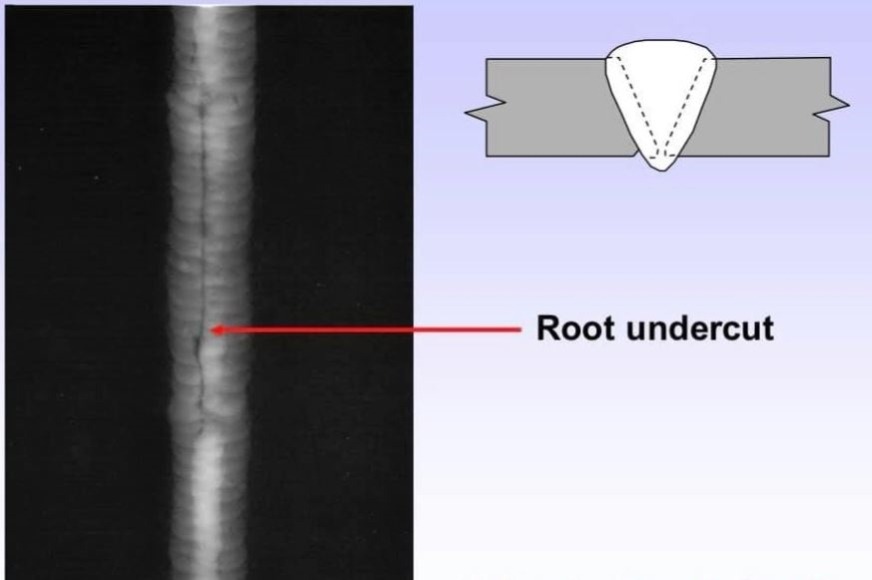Comprehending the Causes and Solutions for Undercut Welding in Metal Fabrication Procedures
In the realm of metal construction processes, the occurrence of undercut welding positions a considerable challenge that demands a detailed understanding of its reasons and sensible services. The detailed interplay of different variables throughout welding procedures can bring about this unfavorable sensation, affecting the architectural integrity and total top quality of the bonded joints - Preventing weld undercut. By studying the origin triggers of undercut welding and discovering efficient therapeutic measures, producers can elevate the criterion of their handiwork and ensure the manufacturing of flawless steel elements
Common Root Causes Of Undercut Welding
Regularly overlooked in metal construction, undercut welding takes place as a result of different variables that require thorough attention and expertise to be efficiently reduced. One typical reason for undercut welding is extreme warm input. When the warmth input is expensive, it can bring about the melting and subsequent disintegration of the base material along the sides of the weld joint, producing a groove or undercut. In addition, inappropriate welding methods, such as utilizing the wrong welding angle or take a trip rate, can likewise add to damage development. Inadequate shielding gas insurance coverage is another crucial variable that can cause undercutting. Not enough gas insurance coverage stops working to secure the weld swimming pool properly, causing oxidation and undercut flaws. Moreover, the selection of welding criteria, such as voltage, current, and cord feed rate, plays a substantial duty in the incident of undercut welding. Understanding these usual reasons is vital for executing preventive measures and making certain top notch welds in metal fabrication processes.
Effect of Incorrect Welding Parameters
Imprecise welding parameters can dramatically compromise the honesty and quality of welded joints in steel manufacture procedures. The influence of wrong welding specifications manifests in different means, leading to architectural weaknesses and flaws in the welded parts. One critical element impacted by incorrect welding criteria is the penetration deepness of the weld. Insufficient warm input as a result of low welding currents or excessively high traveling rates can cause poor fusion in between the base steels, leading to insufficient joint infiltration and weakened bonds. Alternatively, extreme heat input created by high welding currents or slow travel speeds can lead to extreme and burn-through reinforcement, developing a brittle and unsteady weld framework. Additionally, wrong specifications such as incorrect voltage setups or wrong electrode angles can add to unpredictable weld bead profiles, absence of combination, and increased opportunities of flaws like undercutting. Consequently, thorough interest to welding specifications is paramount to ensure the production of top notch welds with the desired mechanical residential properties and architectural honesty.
Effect of Improper Torch Angle
Inappropriate lantern angle in welding procedures can significantly affect the quality and stability of the final weld joints in metal manufacture procedures. Undercutting is a common welding flaw where a groove forms along the weld toe, compromising the joint and jeopardizing its structural honesty.
A torch angle that is as well high can cause insufficient infiltration, insufficient fusion, and raised spatter. On the other hand, a torch angle that is too superficial can lead to too much penetration, burn-through, and distortion of the base product. Preventing weld undercut. Correct torch angle is essential for ensuring regular weld high quality, stamina, and look
To avoid damaging and various other issues triggered by improper torch angles, welders should be trained to maintain the correct lantern angle throughout the welding procedure. Regular surveillance and modification of torch angles during welding can aid attain audio welds with minimal flaws.
Role of Inadequate Welding Techniques

Another aspect of poor welding techniques is improper weld preparation. Insufficient cleansing of the base steels, wrong joint style, or inadequate side prep work can all add to damage welding. Additionally, poor securing gas coverage or utilizing the wrong type of gas can cause insufficient blend and the formation of undercut problems.
To attend to the duty of poor welding strategies in metal manufacture procedures, it is important to provide extensive training for welders. Appropriate education and learning on welding criteria, joint preparation, and securing gas selection can aid prevent undercut welding and make sure top quality welds in metal manufacture jobs.
Reliable Solutions for Undercut Welding
Dealing with undercut welding in steel construction needs executing efficient remedies to enhance weld high quality and architectural integrity. One of the main services to fight undercut is to readjust welding specifications such as voltage, present, and travel rate to make sure appropriate heat input and blend. By fine-tuning these settings, welders check my source can prevent excessive melting of the base steel and filler product, lowering the likelihood of undercut formation.
Furthermore, correct joint prep work is important in preventing undercut. Making certain tidy base steel surface areas devoid of pollutants and making use of the suitable bevel angle can help advertise much better weld infiltration and reduce the danger of undercut - Preventing weld undercut. Utilizing suitable welding methods, such as oscillating the torch or weaving, can likewise help in dispersing heat equally and filling the weld joint properly, lessening the possibility of undercut issues
Furthermore, selecting the proper welding consumables, consisting of electrodes and filler steels, is important in mitigating undercut. Making use of products with appropriate chemical compositions and mechanical residential or commercial my sources properties can add to achieving sound welds with marginal undercut. Routine examination and quality control procedures must additionally be implemented to spot and attend to undercut concerns promptly, making sure the overall honesty of made metal elements.

Conclusion
Finally, recognizing the causes and remedies for undercut welding in metal fabrication processes is important for accomplishing top notch welds. By attending to common causes such as wrong welding criteria, improper lantern angle, and poor welding techniques, welders can prevent damaging and ensure strong, resilient welds. It is necessary to take notice of these variables and apply efficient remedies to improve the general welding procedure and end product quality.
